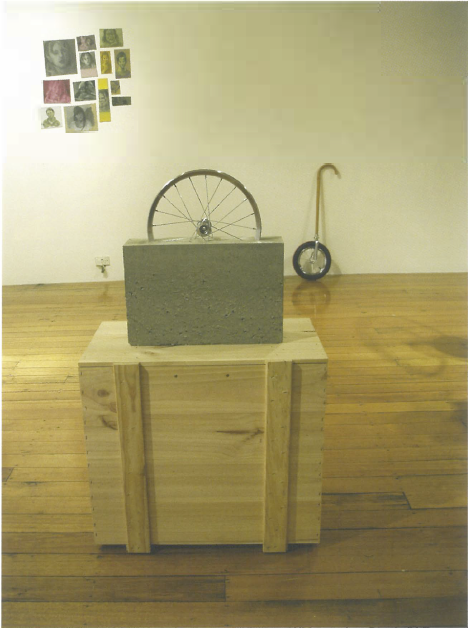
Like trying to read signs in a foreign language, these artists (Cate Consandine, Louise Hubbard, Gerard McCourt, Sanja Pahoki, Emidio Puglielli and Mark Rose) are trying to keep it together in an era of uncertainty. Their work inspires that feeling and, as Puglielli writes in the exhibition premise, the world perceived as difficult is a reflection of modernity. Or do their anxieties result from choosing critical engagement with their culture rather than blind submission?
Louise Hubbard has stacked an old paint stained tennis table in halves against the wall along with other carefully arranged items. I am tempted to unravel the mystery of potential signs awaiting interpretation. A doll, two letters, plastic horses, lots of soap, a horse drawn with a plastic chain tethered to a stack of plastic side tables. Tables? Horse, tables – stables? Chain, links & what does it mean? I don't know, but it's called Rodeo and has something to do with training.
Further along the wall, isolated, is a large photograph of a grimy stainless steel toilet flusher inviting us to choose between full and half. I try to see the photographer reflected in the shiny buttons but can't quite make Sanja Pahoki out. The pinned photo looks as if wiped with a dirty cloth but it's really the parallel surface of the flusher and a moment of visual confusion between real and represented ensues. The Test, a bland video of people struggling to pronounce mostly French words, inspires thoughts of alienation and elitism by revealing how strange these 'art theory' words are to outsiders.
Nearby are four identical photographs almost overlapping as they curl at the bottom. The images have been laboriously erased until all we see is a faint reminder of what once was. Emidio Puglielli's photos take away the very thing we expect to see in photographs by abrading that glossy surface and scratching difference into sameness. The faded images reveal their common ground.
Cate Consandine leaves us with soft hues marking out the agitated evidence of her made-up face pressed rubbing against the wall. The central gap of bare white is heightened by the expressive eye-shadow and lipstick marks smeared around it – she must have sat astride something she has removed. It's about removal.
Gerard McCourt leans a tricycle wheel with a cane handle for a seat and rubber stamps on the tyre tread against the wall. Another wheel is nearby, imbedded in concrete and looking very neat, it will never roll again. A more complex wheel thing attached by a cable to a can-opener that doesn't work stands readymade and ready to be read with its reflective mirror looking back at us from its black stool. McCourt's works reference Duchamp but seem to make no obvious statement other than to be very neat, well-presented and insistently there.
Crammed tightly in behind are two groups of small paintings by Mark Rose. They are subdued, flat, tonal, haphazard, roughly cut, quick, fleeting representations of people's faces mostly. Some repeat the same image. He shares his endearing struggles to get it right with us in a disarmingly honest and frank way. He seems to care more about painting than about the subject, it could be anything. They are probably all self-portraits even though they're not of him.
A mix-tape soundtrack plays in the background convincing me that this exhibition is about the complexity of contemporary life and also the lurking Nihilism behind things? It is cool, detached, impersonal, difficult, spare and equally complex, considered, challenging, grave and edgy. Ill and Vexed achieves its goal of expressing difficulty but perhaps that's just what people don't want more of?












